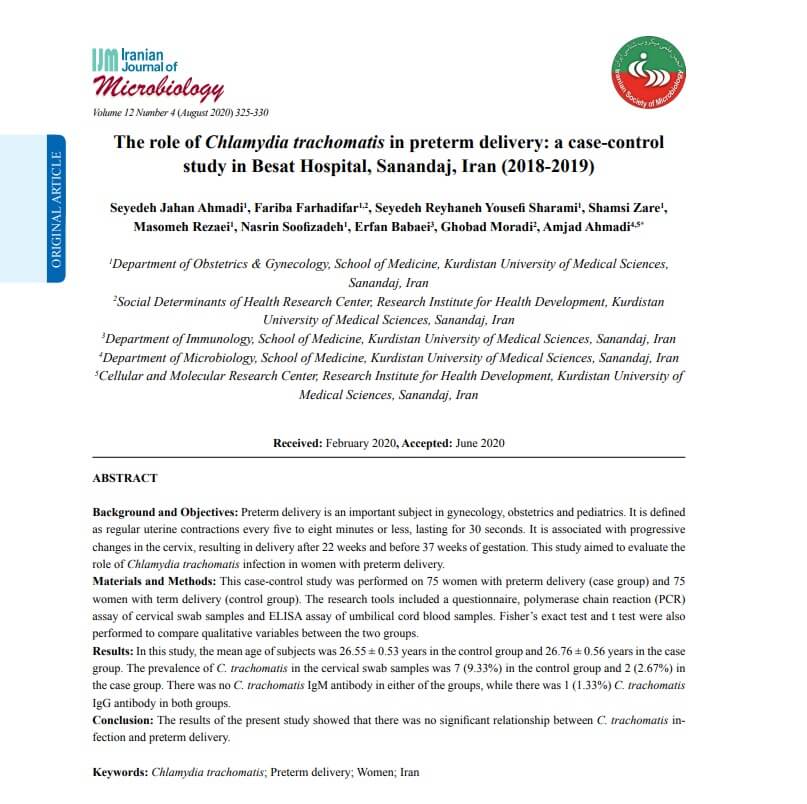The role of Chlamydia trachomatis in preterm delivery: a case-control study in Besat Hospital, Sanandaj, Iran (2018-2019)

The role of Chlamydia trachomatis in preterm delivery: a case-control study in Besat Hospital, Sanandaj, Iran (2018-2019)
Seyedeh Jahan Ahmadi’, Fariba Farhadifar12, Seyedeh Reyhaneh Yousefi Sharami’, Shamsi Zare’, Masomeh Rezaei’, Nasrin Soofizadeh’, Erfan Babaei3, Ghobad Moradi2, Amjad Ahmadi+5
‘Department of Obstetrics & Gynecology, School of Medicine, Kurdistan University of Medical Sciences, Sanandaj, Iran
*Social Determinants of Health Research Center, Research Institute for Health Development, Kurdistan University of Medical Sciences, Sanandaj, Iran
‘Department of Immunology, School of Medicine, Kurdistan University of Medical Sciences, Sanandaj, Iran *Department of Microbiology, School of Medicine, Kurdistan University of Medical Sciences, Sanandaj, Iran “Cellular and Molecular Research Center, Research Institute for Health Development, Kurdistan University of Medical Sciences, Sanandaj, Iran
Received: February 2020, Accepted: June 2020
ABSTRACT
Background and Objectives: Preterm delivery is an important subject in gynecology, obstetrics and pediatrics. It is defined as regular uterine contractions every five to eight minutes or less, lasting for 30 seconds. It is associated with progressive changes in the cervix, resulting in delivery after 22 weeks and before 37 weeks of gestation. This study aimed to evaluate the role of Chlamydia trachomatis infection in women with preterm delivery.
Materials and Methods: This case-control study was performed on 75 women with preterm delivery (case group) and 75 women with term delivery (control group). The research tools included a questionnaire, polymerase chain reaction (PCR) assay of cervical swab samples and ELISA assay of umbilical cord blood samples. Fisher’s exact test and t test were also performed to compare qualitative variables between the two groups.
Results: In this study, the mean age of subjects was 26.55 ± 0.53 years in the control group and 26.76±0.56 years in the case group. The prevalence of C. trachomatis in the cervical swab samples was 7 (9.33%) in the control group and 2 (2.67%) in the case group. There was no C. trachomatis IgM antibody in either of the groups, while there was 1 (1.33%) C. trachomatis IgG antibody in both groups.
Conclusion: The results of the present study showed that there was no significant relationship between C. trachomatis in- fection and preterm delivery.
Keywords: Chlamydia trachomatis; Preterm delivery; Women; Iran

![Fifth complement cascade protein (C5) cleavage fragments disrupt the [HTML] f SDF-1/CXCR4 axis: further evidence that innate immunity orchestrates](https://razikurd.ir/wp-content/uploads/2023/07/Fifth-complement-cascade-protein-C5-cleavage-fragments-disrupt-the-HTML-f-SDF-1CXCR4-axis-further-evidence-that-innate-immunity-orchestrates-150x150.jpg)
